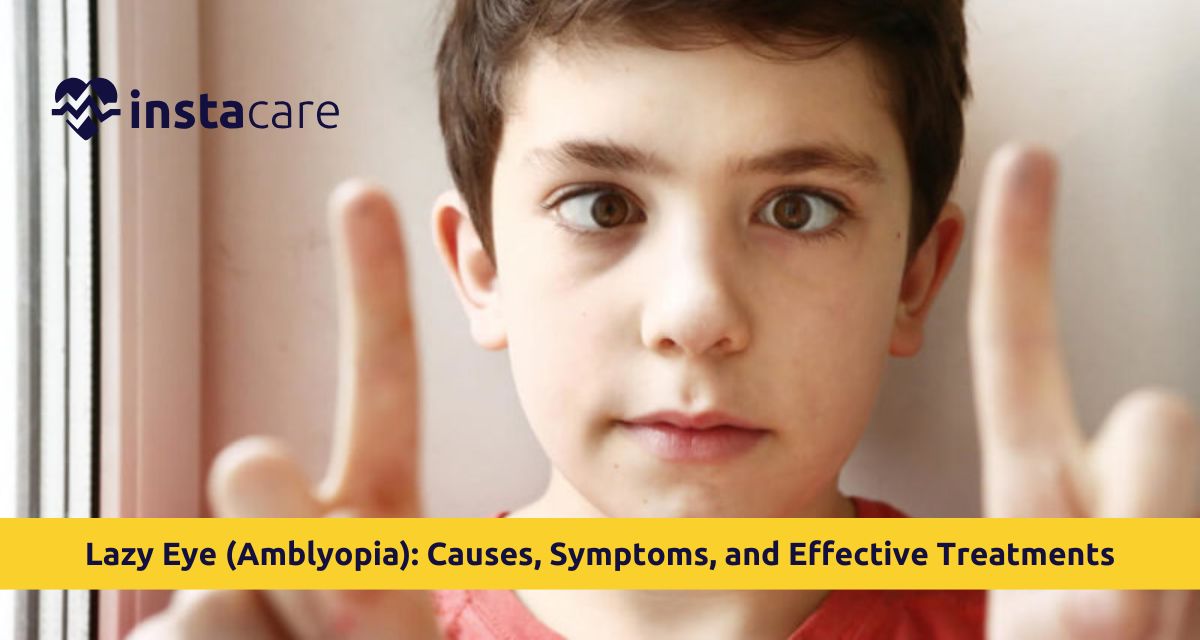Amblyopia, more commonly known as lazy eye, is estimated to affect 2-3% of children worldwide and long considered one of the leading preventable causes of vision loss in a child. Moreover, it is believed that the earlier the condition is caught, the better and more effective the lazy eye treatment tends to be during developmental years.
What Is Lazy Eye (Amblyopia)?
Amblyopia has been commonly referred to as 'Lazy Eye,' wherein one of the eyes has developed weaker vision in relation to the other eye. It also differs from other forms like crossed eyes, which refer to misalignment of the eyes, and may or may not be easily detected at an early stage. Since the brain favors one eye over the other, the weaker eye lags behind in the path of its vision development.
Key things to note:
- It typically involves one eye and rarely involves both.
- If left untreated, it may cause permanent vision loss.
- The key to the effective management of lazy eye is early lazy eye treatment.
Causes of Lazy Eye
Knowing the causes of lazy eye will provide an understanding of the prevention and treatment measures for lazy eye. Common causes include:
- Strabismic Amblyopia: Misalignment of the eyes is a crossed eye wherein the brain ignores the weak eye.
- Refractive Amblyopia: Large discrepancies in the vision of both eyes resulting from nearsightedness, farsightedness or astigmatism.
- Amblyopia of Deprivation: It is caused by ocular occlusions, of which cataract is the most common, that interferes with normal visual stimulation.
- Genetic/Environmental: The genetic predisposition due to family medical history about eye problems or delayed treatment of ocular problems.
The first couple of years of life are when children are most susceptible because the visual system is still developing.
Symptoms and Warning Signs of Lazy Eye
Early detection of the symptoms of lazy eye means there is a better chance for timely lazy eye treatment. Major warning signs to watch out for include:
- Poor vision in one eye
- Eyes that appear misaligned: lazy eye vs cross eye
- Squinting a lot or frequently closing one eye
- Head tilting to use the stronger eye
- Difficulty reading or focusing
- Reduced depth perception
Lazy eye is something parents should look for, but the signs are very subtle. It might just be as simple as noticing blurry vision in one eye or problems with depth perception.
Diagnosis of Lazy Eye
Lazy eye diagnosis typically requires a comprehensive eye test performed by an optometrist or ophthalmologist.
Testing may include the following:
- Tests of visual acuity measure the sharpness of vision in each eye.
- Cover test This test checks for eye alignment and dominance.
- Refraction tests: These tests would determine whether corrective lenses are required.
With dilation of the pupil, this provides a detailed view of the retina and optic nerve.
The key to dyslexia is early lazy eye diagnosis, but while treatment is obviously most effective under age 7, adults can benefit from some treatments as well.
Treatment Options of Lazy Eye
Treatment does vary with the level of severity, its cause, and the age of the patient. Here are some effective lazy eye treatment options:
- Eye Patch Therapy-covering the stronger eye in order to force the weaker eye to work. More commonly used in lazy eye in children.
- Vision Therapy for Lazy Eye- A set of activities customized for the patient that are designed to enhance focus, movement, and coordination of the eyes.
- Corrective Glasses or Contact Lenses – These correct the vision discrepancies responsible for causing refractive amblyopia.
- Most of the surgeries for lazy eye surgery are to correct misalignment of the eyes, especially in strabismic amblyopia.
- Atropine eye drops-Atropine temporarily blurs the stronger eye in hopes of stimulating the weaker eye.
It is often the combination of all these therapies put together that works, such as eye patching in concert with other vision exercises.
Can Lazy Eye Be Treated in Adults?
Although it conventionally has been a childhood condition, lazy eye in adults is treatable into adulthood. While the plasticity of the brain decreases as time goes on, recent studies have shown that even into adulthood, vision therapy and certain specific exercises improve visual acuity.
The main options for treating adults include:
- Vision therapy programs: Eye exercises tailored for adults
- Corrective lenses - For refractive amblyopia.
- Surgical intervention is indicated for conditions that present extreme dental malalignment.
Treatment in adults is usually much slower and can consider the improvement of quality of life and prevention of complications of untreated lazy eye complications, such as a decrease in depth perception or
loss of vision.
Home Remedies and Eye Exercises
In mild cases, lazy eye exercises may supplement professional treatment:
- Pencil push-ups: This exercise improves eye coordination, wherein the eyes focus on a pencil that is approaching the nose.
- Computer-based exercises These are programs designed to stimulate the weaker eye.
- Eye tracking and focusing exercises: These help in strengthening vision by following objects with the weaker eye.
- Occlusion therapy at home includes using patches or blur lenses according to the doctor's recommendation.
Consistency is key in doing the lazy eye exercises, as it enhances the result of the treatment when done daily.
Prevention Tips of Lazy Eye
It is far easier to prevent amblyopia than it is to treat it. The following are some tips:
- Regular eye exams should be scheduled for children starting from infancy.
- The refractive errors of the eyes should be corrected with the use of eyeglasses or contact lenses.
- The eye conditions, including cataracts, need to be treated as soon as possible.
- The children should be observed in case of misalignment or squinting of their eyes.
- Good nutrition, especially food rich in vitamin A, along with omega-3 fatty acids, will keep the eyes healthy.
Early detection and intervention may reduce the possibility of a long-term visual disability.
Conclusion
Lazy eye, or amblyopia, is treatable, and it can be treated if the problem is detected early enough. Knowing what causes of lazy eye, the symptoms of lazy eye, and looking for professional lazy eye diagnosis are important steps in preventing and treating lazy eye. Modern treatments, including eye patch therapy, vision therapy for lazy eye, and lazy eye correction glasses, not only restore the vision but also improve the quality of life for both lazy eye in children and lazy eye in adults. Take action today because early lazy eye treatment ensures better outcomes, preventing untreated lazy eye complications.
Please book an appointment with the
best Eye Specialist in Lahore, Karachi, Islamabad, and all major cities of Pakistan through
InstaCare, or call our helpline at 03171777509 to find a verified doctor for your disease.

